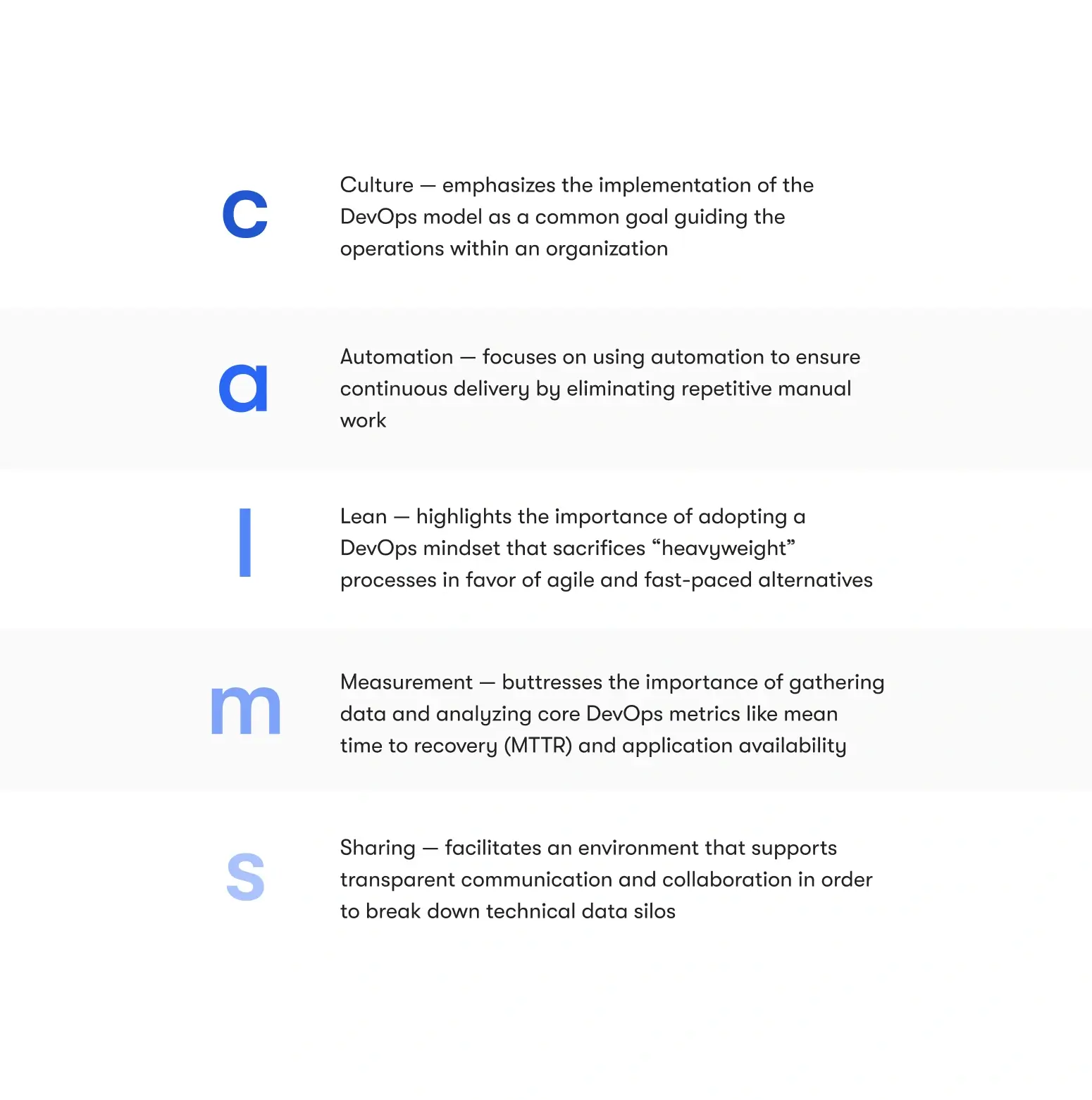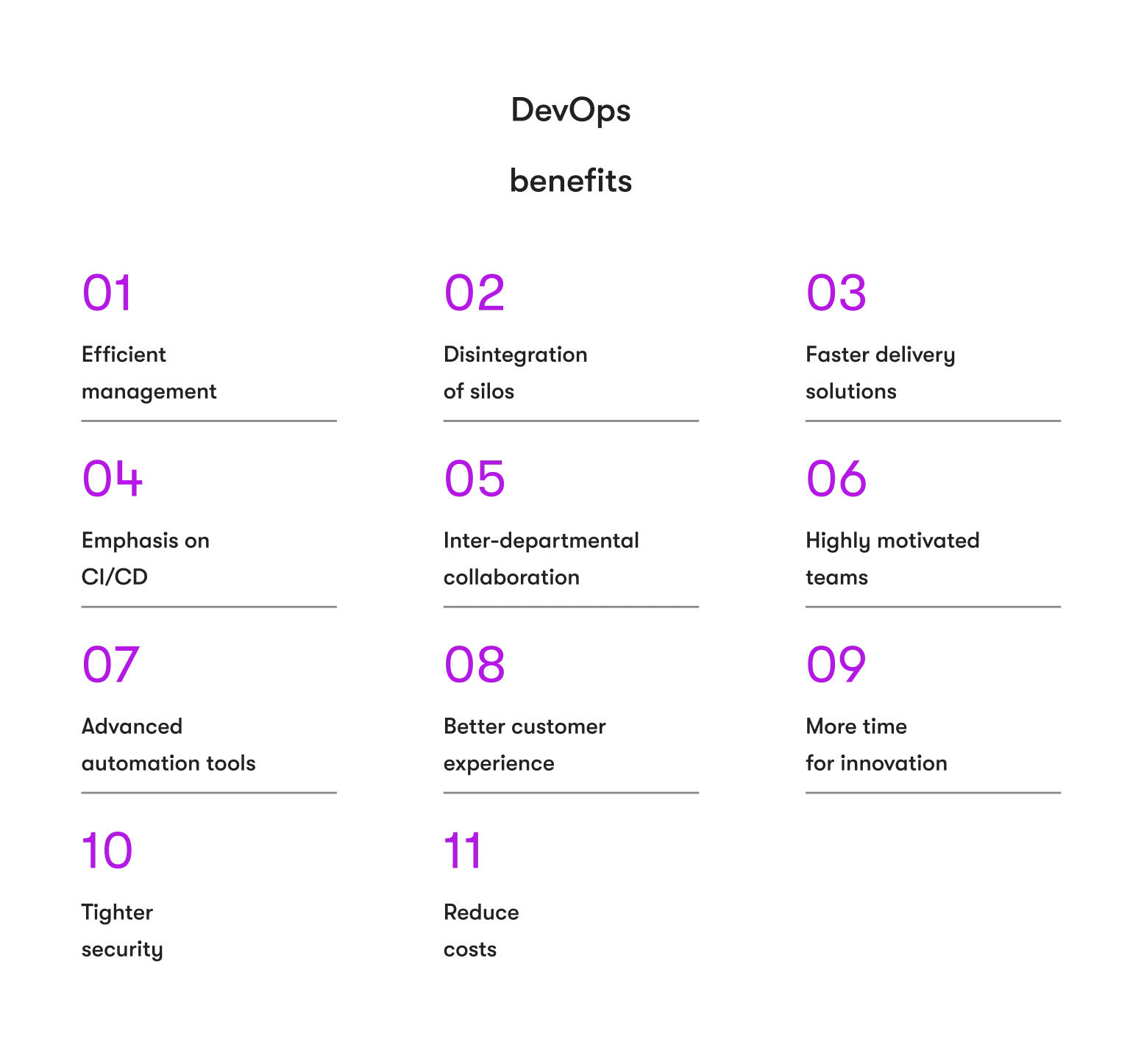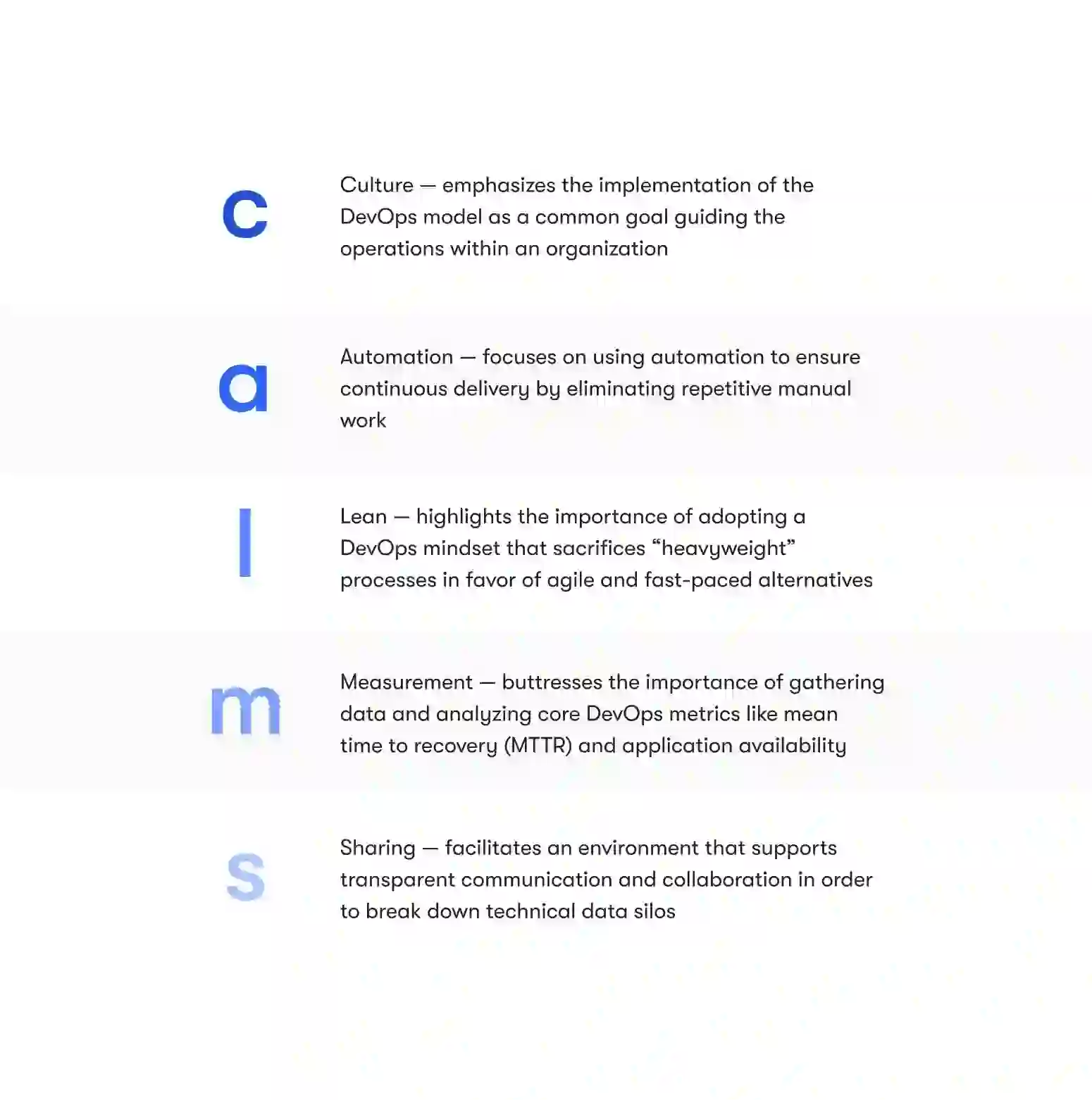Over the past decade, companies have started adopting DevOps practices for their product development projects. This relatively new compound set of practices has gained a lot of popularity, reaching a market value of $7 billion in 2022.
Multinational corporations like IBM, Microsoft, and Atlassian champion the DevOps transformation due to its positive impact on software development cycles. But despite the widespread implementation of DevOps practices, this methodology has a few drawbacks that every business owner and manager should consider.
In this article, we will discuss the advantages of DevOps methodology for businesses. Continue reading to discover how adopting this methodology can impact customer satisfaction and workplace culture.
A brief overview of the DevOps methodology
The term “DevOps” is a product of the marriage between development (Dev) and IT operations (Ops). This term became popular around 2007, with people like Patrick Dubois, Gene Kim, and John Willis pioneering this movement.
In the past, software development efforts used to be the Wild West; development and IT operations teams regularly clashed on the best practices for software development, testing, and deployment. These clashes often went from fundamental disagreements to complete dysfunction within organizations.
To address the inefficiency of traditional development methods, the best developers and operations specialists gathered in online forums, resulting in the birth of DevOps ideology. And since then, companies have been enjoying the benefits of DevOps for business growth and development.
How does DevOps work?
Before discussing the benefits of DevOps implementation, let’s explore how it works in practice.
So, imagine that your company wants to build a product for customers. This product has to pass through five core stages: building, testing, releasing, planning, and monitoring. These stages make up the delivery pipeline.
With the DevOps model, both the development and operations teams work together throughout the product’s life cycle, instead of functioning as separate entities.
In essence, the developers are also part of the testing stage, even though QA specialists are in charge. For the security team, managers need to adopt a slightly different version of DevOps called DevSecOps.
You will also need automation to streamline the collaboration and information sharing between independent teams working on the product. These tools discourage the creation of information silos, increasing the speed of deployment and release.
Principles of DevOps
Every DevOps strategy must follow a system of five core principles in order to succeed. This system is called CALMS: Culture, Automation, Lean, Measurement, and Sharing.
Here is what CALMS entails:

Why does your project need DevOps?
You are probably wondering if the DevOps model will work for your project development. We understand your hesitation, so we’ve gathered some reasons explaining why you should implement DevOps immediately.
For starters, companies that don’t work with the DevOps methodology often end up with information silos due to the isolation of teams working on the product. But if you want to centralize and unify information, you must adopt a functioning DevOps model.
Aside from that, every project that requires fast-paced releases and updates has to adopt a DevOps approach. Otherwise, you risk missing your time-to-market and ultimately losing out to your competitors.
As for DevOps benefits for business, this model will help you save money on projects by reducing bottlenecks and fast-tracking the release timeline. And since DevOps puts the consumer front and center, you will gain useful feedback that translates to increased business returns.
Now let’s view DevOps business benefits by the numbers.
According to an Atlassian report, 99% of companies claim that DevOps has positively impacted their business operations. These same companies also claim that switching to a DevOps model helped them improve product quality by 61% and deployment frequency by 49%.
Most importantly, implementing the DevOps approach comes with the adoption of automated processes within the CI/CD timeline. This approach reduces the gravity of mistakes resulting from human error, as well as improves the overall productivity of teams.
LOOKING FOR WORLD-CLASS DEVOPS ENGINEERS?
Understanding the DevOps toolchain
In the ever-evolving software development and deployment landscape, adopting DevOps practices has become a cornerstone for organizations striving to achieve faster delivery, improved quality, and increased collaboration between development and operations teams. DevOps's core is a toolchain — tools that automate and streamline the software delivery process, from code commit to production deployment.
Planning and setting requirements
The journey of any successful software project begins with careful planning. In the planning phase, teams define business objectives, outline project requirements, and establish the roadmap for development. Tools like Jira, Trello, or Asana provide a collaborative platform for project management, enabling teams to track tasks, prioritize work, and maintain alignment with business goals. Version control systems like Git or Subversion ensure that changes to project assets are tracked and managed effectively, laying the groundwork for seamless collaboration throughout the development process.
Collaboration and communication tools
Effective communication and collaboration are essential for successful DevOps practices. Collaboration tools such as Slack, Microsoft Teams, and Atlassian Jira facilitate communication among team members, enabling seamless collaboration, task management, and issue tracking. These tools promote transparency, accountability, and alignment across development and operations teams.
Testing & QA tools
Quality assurance is a cornerstone of software development, and the testing phase is where software undergoes rigorous testing to ensure its quality, reliability, and performance. Continuous testing tools like JUnit, TestNG, or Selenium facilitate automated testing, allowing teams to execute test cases, generate test reports, and identify defects early in the development lifecycle. Test automation frameworks like Cucumber, Robot Framework, or TestComplete enable teams to automate functional, regression, and performance testing, accelerating the testing process and improving overall software quality.
Version control systems (VCS)
A robust version control system is fundamental to any DevOps workflow. VCS tools such as Git, Mercurial, and Subversion enable teams to manage changes to source code efficiently, facilitating collaboration and ensuring version control. Among these, Git has emerged as the de facto standard, offering distributed version control, branching strategies, and integration capabilities with various DevOps tools.
Integration tools
Continuous integration frequently integrates code changes into a shared repository, followed by automated builds and tests. CI tools such as Jenkins, CircleCI, and Travis CI automate the build and test process, providing real-time feedback to developers. These tools enable teams to detect and fix integration errors early, ensuring the stability and quality of the codebase.
Deployment tools
Continuous deployment extends the CI process by automating the deployment of code changes to production environments after passing the necessary tests. CD tools such as Kubernetes, Docker, and Ansible facilitate the deployment and configuration of applications across different environments, including development, testing, and production. By automating deployment pipelines, CD tools help teams achieve faster time-to-market and reduce the risk associated with manual deployments.
Configuration management tools
Configuration management tools are essential for maintaining consistency and managing infrastructure as code. Tools like Puppet, Chef, and Ansible automate the configuration and provisioning of servers and infrastructure components, enabling teams to define infrastructure requirements in code and enforce desired state configurations across environments. These tools promote repeatability, scalability, and reliability in the deployment process.
Monitoring and logging tools
Monitoring and logging tools are crucial for gaining insights into the performance and health of applications and infrastructure. Prometheus, ELK Stack (Elasticsearch, Logstash, Kibana), and Splunk enable teams to monitor metrics, collect logs, and analyze system behavior in real time. By proactively detecting issues and identifying bottlenecks, monitoring and logging tools empower teams to ensure the availability and reliability of their applications.
Top 11 DevOps benefits for your business
We’ve briefly touched on how DevOps can help your teams become more productive; now it’s time to detail the benefits of adoption of DevOps practices.

Efficient management process
Employing the DevOps strategy makes the jobs of managers and team leads easier. As a product or project manager, you no longer need to struggle to get your developers and operations teams on the same page; they will function in harmony under the DevOps umbrella.
Even if teams disagree on the right approach for a specific product, the manager will have an easier job resolving the conflict because everybody is reading off the same centralized playbook.
And most importantly, modern automation tools can help managers optimize task scheduling, reporting, and feedback processing. All in all, this reduces bottlenecks and redundancies that could clog the product delivery pipeline.
Disintegration of silos
We’ve addressed this point earlier, but let’s reiterate with a further explanation. Here is how silos originate:
Traditional development strategies confine every department to its own echo chamber. Developers write their code and build components without interference or collaboration from operations and security, leading to information silos within the pipeline.
But under the DevOps umbrella, these otherwise-isolated silos are instead integrated toward a central goal that every team must focus on. And with cloud-based data management tools, managers and C-suite executives can synthesize the data easily.
Faster delivery of solutions
In the current tech atmosphere, speed is a crucial driving factor for businesses trying to stay competitive. The DevOps culture will help your business increase the speed of deployment and release by removing obstacles like interdepartmental conflicts and dysfunctional feedback loops.
According to the 2021 Accelerate State of DevOps Report, elite and high-performance teams deploy 973x more frequently and have 6750x faster lead times compared to low performers.
You can also increase productivity and release frequency using automation tools to optimize processes. Businesses that can release updates and fix bugs faster will always gain a competitive advantage.
Emphasis on continuous integration and delivery (CI/CD)
Continuous integration is a software development practice in which changes to the codebase are merged in a central repository. This practice helps developers and QA engineers detect bugs faster in order to reduce the time required to address them as well as release revamped updates.
In the same vein, continuous delivery involves automatically building, testing, and releasing changes to the code. Since CD pushes the code automatically to testing and standardization, your organization will always have artifacts ready for deployment.
So when your company uses CI/CD practices in the development lifecycle, your product will be able to evade all obstacles that could affect the delivery speed.
Better inter-departmental collaboration
As mentioned earlier, one of the core benefits of using DevOps strategies is that it fosters collaboration and communication between departments.
Every high-performing team has an ingrained culture of transparency and trust fuelled by a robust, two-way feedback mechanism. This close collaboration also leads to workplace harmony, which fosters a culture of respect.
And with the help of modern communication and collaboration tools like Slack and Google Apps, adopting the DevOps mindset will ensure that your teams can work on problems together to deliver a consumer-friendly product.
Highly motivated teams
Adopting a DevOps culture helps companies establish a friendly working environment that fosters transparency, close collaboration, and respect. In such workplaces, the team morale always stays high.
Another factor that affects the morale of teams working on a product is unplanned work.
In DevOps terms, unplanned work refers to all optimization processes and unprecedented changes to the project that weren’t part of the original project plan. For example, the time the developer spends fixing a bug falls under the unplanned work category.
Undoubtedly, you can boost team morale by establishing a system for proactively dealing with unplanned work. This will also help your engineers and developers to buy into the DevOps methodology, because they will end up working smarter and faster.
Advanced automation tools
The success of your DevOps strategy relies heavily on the toolchain at your disposal. This toolchain accounts for every tool or technology used by development and operations teams during the software lifecycle.
DevOps automation includes development tools for continuous integration and delivery, testing, feedback, risk management, logging, and deployment.
Consider adding these automation tools to your toolchain:
- Monitoring (SignalFx, AppDynamics, Nagios, Dynatrace, Splunk, Opsgenie, and NewRelic)
- Security (IriusRisk, Alert Logic, Halo, Gerrit, Phabricator, Imperva Rasp, SpotBugs, PMD, and CheckStyle)
- Testing (AccelQ, BDD Automated Security Tests, Selenium, OWASP ZAP, Ranorex, IBM AppScan, GAUNTLT, and SecApp suite)
- Building (Docker, Terraform, Puppet, Chef, Ansible, and Kubernetes)
- Deployment (Osquery, DataDog, Falco, AWS CodePipeline, and Tripwire,)
- Continuous integration and delivery (Jenkins, Bitbucket, AWS, SonarSource, SauceLabs, Zephy, IBM Urbancode).
- Communication and collaboration (Slack, Jira, Confluence, GetFeedback, Pendo)
Better customer experience
The DevOps model relies on feedback, not only from internal teams but also from consumers, clients, and stakeholders. This open feedback loop makes it possible for organizations to get a bead on consumer sentiments when building a product.
Let’s say your payment app is about to enter the development pipeline; implementing a DevOps strategy will help you stay in touch with the app’s target audience throughout its lifecycle. By doing so, you will be able to address concerns through updates and new features.
Ultimately, the app's final version will appeal to members of your target audience by meeting the time-to-market as well as addressing their primary pain points.
More time for innovation
DevOps fosters innovation by harnessing the power of individual expertise, research data, and process automation. All these variables contribute to the quality of the product’s final version.
Also, rapid software delivery allows your organization to fail early and make the requisite changes with enough leeway to meet the initial release target. As a result, your developers will get the chance to experiment with new features and components for the product’s architecture.
Most importantly, maintaining an open feedback loop reduces the mean time to response (MTTR), which helps QA engineers analyze and respond to concerns about software errors and other potential vulnerabilities.
Tighter security
With the rate of cybercrime continuously increasing, a well-crafted and adequately implemented DevOps strategy can bolster the security of your business infrastructure and your product’s security.
DevSecOps (development, security, and operations) is an approach to infrastructure design that integrates security throughout the IT lifecycle. DevSecOps improves the recovery speed through incremental improvements, automated compliance policies, and granular controls.
However, DevSecOps is interwoven into the overall software pipeline instead of being a standalone unit. This approach reduces cost and shortens timelines by outlining potential flaws during the early stages of the development effort.
For this reason, you must adopt the DevSecOps model throughout the delivery pipeline to protect your organization’s intellectual property.
Reduced costs
On the surface, implementing a DevOps strategy might sound expensive, owing to the significant number of automated processes that go into it. But the reality is that the DevOps model helps companies reduce costs.
- Network downtime costs — the stability and availability that DevOps practices provide will help you save money that you would have lost when fixing downtimes. Automated testing, performance monitoring, and CI/CD practices will help you detect and identify the root cause of issues.
- Software release costs — automating your release and delivery pipeline saves you money by removing redundancies that add to the overall cost.
- Operational costs — this covers all the expenses spent on buying tools, hiring new specialists, and deploying stable application versions. Your DevOps strategy will help you mitigate these expenses through the use of automation tools and cloud technology.
NEED SOME HELP WITH YOUR DEVOPS TEAM?
DevOps best practices: maximizing the advantages and benefits of DevOps
DevOps isn't just a set of practices; it's a cultural shift that can impact an organization's software delivery process. By embracing DevOps best practices, teams can unlock many benefits and advantages that streamline development, enhance collaboration, and drive business value.
Cultivate DevOps leadership
Effective leadership is essential for driving cultural transformation and championing DevOps initiatives within your organization. Cultivate leaders who embody DevOps principles and lead by example. Empower them to inspire, motivate, and support teams in embracing change, experimenting with new ideas, and striving for excellence.
Automate processes
Automation lies at the heart of DevOps, and for good reason. By automating repetitive tasks such as build, test, deployment, and infrastructure provisioning, teams can significantly reduce manual errors, increase efficiency, and accelerate delivery speed. The benefits of DevOps automation extend beyond speed and accuracy; it also frees up valuable time for teams to focus on higher-value activities, such as innovation and problem-solving. Generative AI can provide an added advantage here.
Foster cross-functional teams
Break down organizational silos and foster cross-functional teams that encompass diverse skill sets and perspectives. Encourage collaboration between developers, operations engineers, QA specialists, and other stakeholders. By working together towards common goals, teams can leverage collective expertise, share responsibilities, and deliver value more efficiently.
Continuously iterate and evolve
DevOps is an iterative process, not a one-time implementation. Embrace a mindset of continuous improvement and evolution. Regularly review and reflect on your DevOps practices, solicit stakeholder feedback, and identify areas for enhancement. Iterate on your processes, tools, and methodologies to adapt to changing business requirements and market dynamics.
Monitor and measure performance
Continuous monitoring of applications and infrastructure is crucial for identifying performance bottlenecks, detecting anomalies, and ensuring optimal system health. Implement monitoring tools and dashboards to track key performance metrics in real time. Use data-driven insights to identify areas for optimization and make informed decisions that drive efficiency and reliability.
Foster a culture of continuous learning and improvement
Continuous learning and improvement are fundamental to DevOps success. Encourage a culture of experimentation, feedback, and knowledge sharing within your organization to take advantage of DevOps best practices. Invest in training and development initiatives to upskill team members and keep them abreast of emerging technologies and best practices. By fostering a continuous learning and improvement culture, organizations can adapt to evolving challenges, seize opportunities, and stay ahead of the competition.
Possible DevOps drawbacks to bear in mind
With a better understanding of the core benefits of DevOps and its advantages for businesses, let’s address the potential challenges to implementing this model.
Talent recruitment
Even if you have the perfect DevOps strategy, you will still struggle to meet product development expectations if you don’t have skilled employees.
According to the Atlassian report referenced earlier, 37% of companies are facing difficulties implementing a winning strategy due to a lack of skilled employees.
Besides, finding a DevOps engineer in the current global workforce is challenging. And after finding the right candidate, you still need to get them up to speed with your internal workflow — which cuts into the time dedicated to building the product. However, the managed IT services model can mitigate these difficulties.
Legacy systems
Your DevOps model can only work if you have the right systems in place. If you are working on a legacy infrastructure — like 36% of companies implementing DevOps — you will find it difficult to adopt a modern, automated DevOps strategy. It is just like building a new house on an older (and possibly decrepit) foundation.
In most cases, you will need to shift your monolithic architecture to microservices — which is essential to the success of DevOps. As a result, you might end up missing your release date by several weeks or months.
All in all, you need the right tools in place if you want the project to reach completion without several delays.
Metrics and KPIs
As a core principle of DevOps, you must measure the results of every stage by tracking metrics. But the problem comes in identifying the right metrics to track.
Companies like Atlassian and Amazon recommend tracking four core performance indicators: Lead time, change failure rates, deployment frequency, and mean time to recovery (MTTR).
However, these KPIs are insufficient if you want to enjoy the business benefits of DevOps. To make sure the product addresses the pain points of actual end users, you need to track metrics like application performance, application availability, error rate, uptime, and downtime. Read more about this in the article: “DevOps Metrics and KPIs”.
Why adopt DevOps with EPAM Startups & SMBs?
EPAM Startups & SMBs offers world-class DevOps services to businesses in all sectors. Our experts are familiar with Scrum, Kanban, and CI/CD practices. They also know how to implement them in fast-tracking delivery in order to meet deadlines.
Our talent pool comprises development experts with hands-on experience working with Fortune 500 companies. This wealth of experience will come in handy when you are looking to scale your business operations fast and enjoy the key benefits of DevOps to company transformation.
Moreover, we have developers from all parts of the globe, covering all time zones in North America as well as 3 European time zones. As a result, you will remain in sync with us at any time of the day if you want to monitor progress reports.
And most importantly, you will get access to top-notch DevOps delivery through our meticulous code review, rigorous testing, and adherence to compliance standards: HIPAA, PCI DSS, and GDPR.
Conclusion
Implementing a DevOps methodology for your software development projects will help your business release high-quality products faster. You will also be able to revamp the workplace culture by fostering automation and innovation. Other benefits of DevOps adoption in projects can be seen in increased ROI, better customer satisfaction, and improved employee performance.
If you want your organization to usher in a lucrative DevOps model, use the recommendations in this article to start immediately.
WANT TO BOOST YOUR SDLC WITH DEVOPS PRACTICES?
FAQ

Expert digital communicator and editor providing insights and research-based guides for technology buyers globally.
Expert digital communicator and editor providing insights and research-based guides for technology buyers globally.
Explore our Editorial Policy to learn more about our standards for content creation.
read more






















